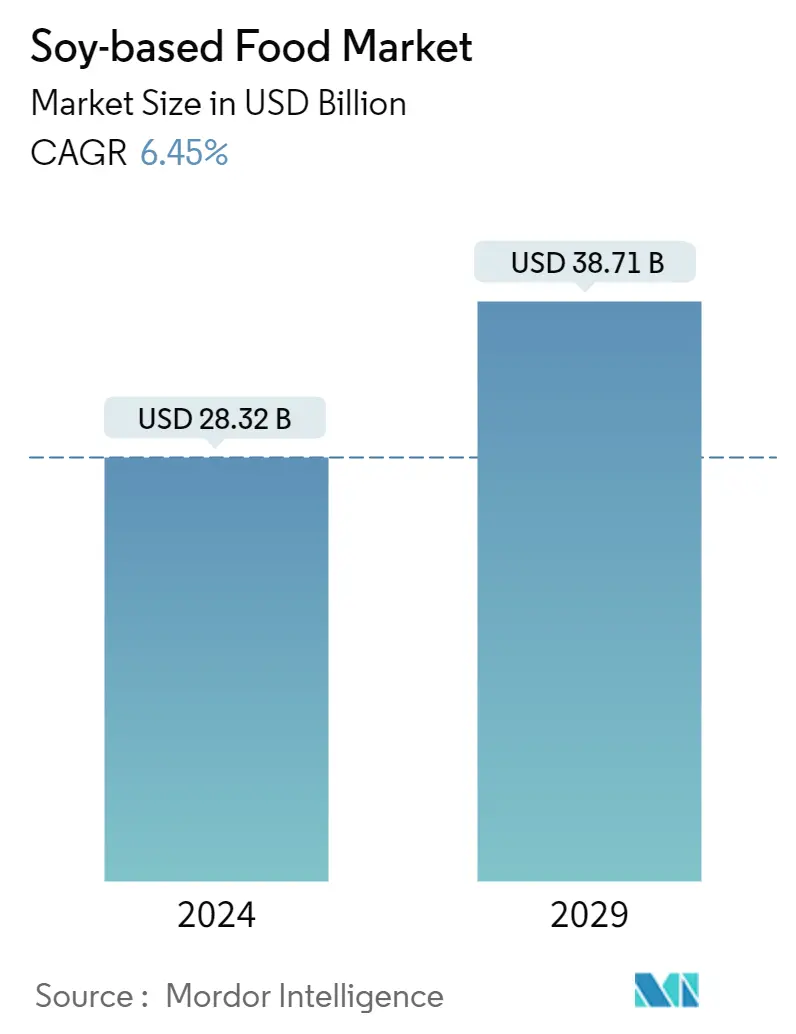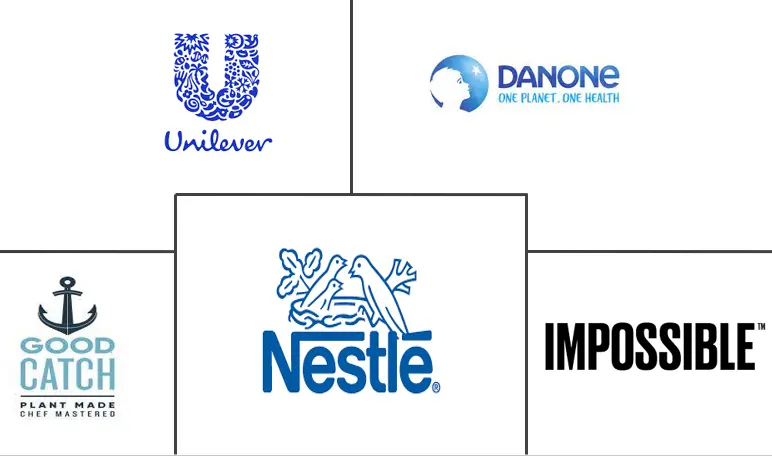Market Size of Soy-based Food Industry

| Study Period | 2019 - 2029 |
| Market Size (2024) | USD 28.32 Billion |
| Market Size (2029) | USD 38.71 Billion |
| CAGR (2024 - 2029) | 6.45 % |
| Fastest Growing Market | Middle East and Africa |
| Largest Market | Asia-Pacific |
Major Players
*Disclaimer: Major Players sorted in no particular order |
Soy Based Foods Market Analysis
The Soy-based Food Market size is estimated at USD 28.32 billion in 2024, and is expected to reach USD 38.71 billion by 2029, growing at a CAGR of 6.45% during the forecast period (2024-2029).
The growing concerns among consumers about the consumption of conventional animal-based food and beverage products and the adoption of vegan diets in the wake of the COVID-19 outbreak due to rising health awareness positively impacted the soy-based growth of the food market. The COVID-19 pandemic has also resulted in the generation of opportunities for many private players to emerge in the market and cater to the inflated demand. Also, the demand for packaged soy-based meat products is consistently high because they are considered safe. According to the Plant-based Foods Association, during the coronavirus outbreak, plant-based meat retail sales increased by 148% more than last year. During the weeks following April, plant-based meat sales continued to grow at a rate of 61%, which was almost twice as high as animal-based meats during the same period.
Over the medium term, the emergence of soy-based food products clearly demonstrates a shift in customer demand from animal-based products to plant-based products, with soy-based foods holding a prominent share. This incremental shift toward a plant-based diet is primarily influenced by ecological concerns, health consciousness, ethical or religious beliefs, and awareness about environmental issues and animal rights.Though animal-based proteins provide the necessary amino acid content, they are associated with high cholesterol levels and other related issues. Thus, consumers in developed countries are increasingly preferring vegan-based protein sources.
Furthermore, the growing preference for plant-based diets and the major meat processors and manufacturers announcing their intentions to join this competition with their line of meat alternatives together present a massive opportunity for plant-based food and beverage consumption. Growing health and sustainability trends are fostering the shift toward vegan/flexitarian diet, which is increasingly favoring soy-based food among consumers, thereby driving the market studied.
Soy Based Foods Industry Segmentation
Soy-based foods are made up of mostly or entirely of soy as their main ingredients with no animal-source foods or artificial ingredients. The global soy-based food market is segmented by type into meat substitutes (sub-segmented into textured soy protein, tofu, and tempeh), non-dairy ice cream, non-dairy cheese, non-dairy yogurt, and non-dairy spread. By distribution channel, the market is segmented into supermarkets/hypermarkets, convenience stores, online retail stores, and other distribution channels. Based on Geography, the market is segmented into North America, Europe, Asia-Pacific, South America, and Middle East & Africa. For each segment, the market sizing and forecasting have been done in value terms of USD million.
| By Product Type | |||||
| |||||
| Non-Dairy Ice Cream | |||||
| Non-Dairy Cheese | |||||
| Non-Dairy Yogurt | |||||
| Non-Dairy Spread |
| By Distribution Channel | |
| Hypermarkets/Supermarkets | |
| Convenience Stores | |
| Online Retail Stores | |
| Other Distribution Channel |
| Geography | ||||||||
| ||||||||
| ||||||||
| ||||||||
| ||||||||
|
Soy-based Food Market Size Summary
The soy-based food market is experiencing significant growth, driven by a shift in consumer preferences from animal-based to plant-based diets. This transition is largely influenced by increasing health awareness, ecological concerns, and ethical considerations, which have been further amplified by the COVID-19 pandemic. The pandemic has not only heightened the demand for safe and healthy food options but also opened up opportunities for new market entrants to cater to this growing demand. The popularity of soy-based meat products, which are perceived as safer alternatives, has surged, with plant-based meat sales outpacing those of animal-based meats during the pandemic. This trend is supported by the rising adoption of vegan and flexitarian diets, as consumers seek healthier and more sustainable food choices.
The market is characterized by intense competition, with both regional and international players such as Kellogg, Gardein, Unilever, and Impossible Foods leading the charge. These companies are actively engaging in product innovation, strategic partnerships, and geographical expansions to strengthen their market positions. The Asia-Pacific region, in particular, is witnessing a surge in veganism, driven by younger consumers who are increasingly embracing plant-based lifestyles. This has led to collaborations between food manufacturers and retailers to expand the availability of soy-based products. The market's growth is further bolstered by the development of innovative soy-based, lactose-free alternatives, catering to consumers with dietary restrictions. As the demand for soy-based foods continues to rise, manufacturers are investing in research and development to enhance product offerings and meet evolving consumer preferences.
Soy-based Food Market Size - Table of Contents
-
1. MARKET DYNAMICS
-
1.1 Market Overview
-
1.2 Market Drivers
-
1.3 Market Restraints
-
1.4 Porter's Five Forces Analysis
-
1.4.1 Bargaining Power of Suppliers
-
1.4.2 Bargaining Power of Consumers
-
1.4.3 Threat of New Entrants
-
1.4.4 Threat of Substitute
-
1.4.5 Intensity of Competitive Rivalry
-
-
-
2. MARKET SEGMENTATION
-
2.1 By Product Type
-
2.1.1 Meat Substitutes
-
2.1.1.1 Textured Vegetable Protein
-
2.1.1.2 Tofu
-
2.1.1.3 Tempeh
-
-
2.1.2 Non-Dairy Ice Cream
-
2.1.3 Non-Dairy Cheese
-
2.1.4 Non-Dairy Yogurt
-
2.1.5 Non-Dairy Spread
-
-
2.2 By Distribution Channel
-
2.2.1 Hypermarkets/Supermarkets
-
2.2.2 Convenience Stores
-
2.2.3 Online Retail Stores
-
2.2.4 Other Distribution Channel
-
-
2.3 Geography
-
2.3.1 North America
-
2.3.1.1 United States
-
2.3.1.2 Canada
-
2.3.1.3 Mexico
-
2.3.1.4 Rest of North America
-
-
2.3.2 Europe
-
2.3.2.1 Germany
-
2.3.2.2 United Kingdom
-
2.3.2.3 France
-
2.3.2.4 Russia
-
2.3.2.5 Spain
-
2.3.2.6 Rest of Europe
-
-
2.3.3 Asia-Pacific
-
2.3.3.1 China
-
2.3.3.2 Japan
-
2.3.3.3 Japan
-
2.3.3.4 Australia
-
2.3.3.5 Rest of Asia-Pacific
-
-
2.3.4 South America
-
2.3.4.1 Brazil
-
2.3.4.2 Argentina
-
2.3.4.3 Rest of South America
-
-
2.3.5 Middle-East and Africa
-
2.3.5.1 South Africa
-
2.3.5.2 Saudi Arabia
-
2.3.5.3 Rest of Middle-East and Africa
-
-
-
Soy-based Food Market Size FAQs
How big is the Soy-based Food Market?
The Soy-based Food Market size is expected to reach USD 28.32 billion in 2024 and grow at a CAGR of 6.45% to reach USD 38.71 billion by 2029.
What is the current Soy-based Food Market size?
In 2024, the Soy-based Food Market size is expected to reach USD 28.32 billion.

